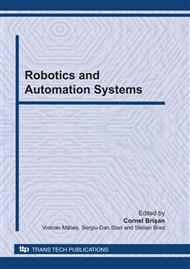p.229
p.235
p.241
p.247
p.253
p.259
p.265
p.271
p.277
Development of Riding Robot System for Entertainment and Healthcare Service
Abstract:
This paper describes the riding robot system named by "RideBot" which is a riding robot like as a horse. In order to simulate the riding motions, we developed the saddle mechanism which can generate 3 DOF motions including pitch, roll, and bounce movement, and also we controlled the riding motions and the intention of horseman. To generate the riding motions with the bodily sensation, we developed Novel Washout Filter and the algorithms for motion control. And also, we developed some health care service for the health care of horseman. A body state index was proposed that evaluates the personal health state from both the measured physiological variables and the surveyed questions. The physiological variables such as weight, blood pressure, heart rate variability (HRV), accelerated state photoplethysmograph(APG), body fat, and happiness index were measured by the specially designed bio-handle system and survey questions. The efficiency of the proposed ride robot is evaluated in the experiments
Info:
Periodical:
Pages:
253-258
Citation:
Online since:
September 2010
Authors:
Keywords:
Price:
Сopyright:
© 2010 Trans Tech Publications Ltd. All Rights Reserved
Share:
Citation:


